In the late afternoon we left Taltal, after cooking some food for the way and baking Granola cookies. This left us only an hour to get away from town. We considered camping in a cave next to the road but eventually preferred the rocky beach, in a flattened area surrounded by a wall that seemed to have been made especially for us. The nice sunset could be seen from inside our tent.
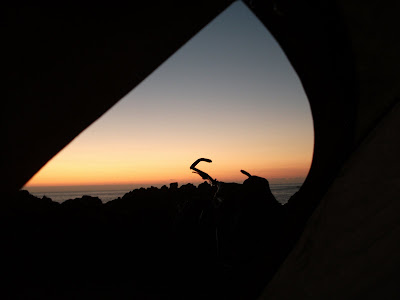
After a peaceful ride along the coast, we got to Paposo just on time to eat lunch in the only restaurant there, chicken soup and a huge piece of fried fish. While eating, we watched the ceremonies of the Chilean independence day as well as the violent protests that seemed to be part of this day. The restaurant owner couldn´t spare any of her drinking water so we filled in some washing water. It took us some time to choose where to continue from there. There was either a newly paved road that started with a long climb, or a road that according to our map was paved and went along the coast all the way to Antofagasta. All the people we asked agreed that we shouldn´t take the coastal road as it was actually a bad unpaved road. We wanted to enjoy the sea a bit more before heading east towards Bolivia, so we chose the coastal road. The road was indeed really bad, but also very quiet.
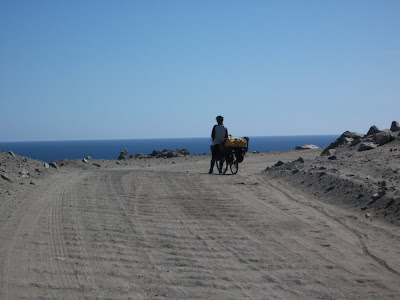
Until the evening we met only 3 cars, all packed with black algae. It wasn´t hard to find a nice place to camp in this deserted road.
Until the evening we met only 3 cars, all packed with black algae. It wasn´t hard to find a nice place to camp in this deserted road.
Algas
When we were ready to leave, we met Fransisco who was taking a walk with his dog. Fransisco is a cheerful guy who collects algae for a living. For a ton of dry algae he gets 120,000 CH$ from a mediator who later sells this on. In a day he collect a ton or two, depending on the sea. The algae are later used for medicines and shampoo. Fransisco brought us to the shed of Jose, who kindly let us fill in all our empty bottles. Jose has an international background: he spent a few years in Quebec, Canada, and his sister lives in Ancona, Italy. He speaks many languages including English, French, Italian, Greek and German. In exchange for their friendliness, we let them try our Granola cookies.

The road was hard to ride on and very sandy, but at least drinking water wasn´t much of a problem. Along the way we saw many sheds of people who, like Fransisco and Jose, collect algae for living. They each had 2 blue containers filled with drinking water that they were willing to share with a smile.
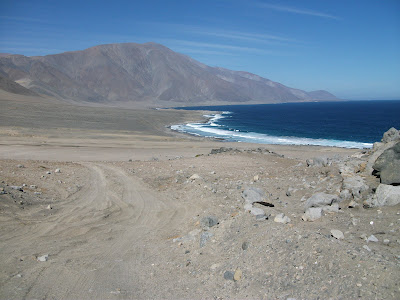
After a long day of hard work, in which we only managed to ride 60 km, we camped next to a lively lagoon: crabs, squids, many types of clams and tiny fish.

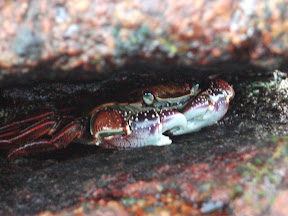
As we still cook vegan for ourselves, we abandoned the idea of boiling crabs for dinner and instead made pasta and Polenta for the following day using only sea water, to save drinking water. The pasta came out a bit too salty but with a nice ocean flavour. However the Polenta was so salty it was almost inedible.
The road was hard to ride on and very sandy, but at least drinking water wasn´t much of a problem. Along the way we saw many sheds of people who, like Fransisco and Jose, collect algae for living. They each had 2 blue containers filled with drinking water that they were willing to share with a smile.
After a long day of hard work, in which we only managed to ride 60 km, we camped next to a lively lagoon: crabs, squids, many types of clams and tiny fish.
As we still cook vegan for ourselves, we abandoned the idea of boiling crabs for dinner and instead made pasta and Polenta for the following day using only sea water, to save drinking water. The pasta came out a bit too salty but with a nice ocean flavour. However the Polenta was so salty it was almost inedible.
El Cobre
A short ride brought us to El Cobre, an abandoned open mine that was now house to 3 guards and a lot of equipment. The guard we met, Nacho, was the only person with clean clothes on this road.

He was happy to explain to us about the history of the place. The mine was active until 15 years ago, and soon it should be reactivated. There are piles of rocks there containing various minerals. These gurds are there to protect the place from theft of the expensive equipment that was left. About a month ago was the last armed robbery attempt during the night, were the robbers tried to take the expensive satellite phone (20,000 US$) the guards use. Nacho let us fill in water and we finished the water tank, so Amit went with him to fetch a new one. He made us an interesting traditional drink from toasted flour, a bit of sugar and a lot of water. Surprisingly it was very tasty and also quite filling.
The End of the Road
Shortly after leaving, we reached a junction. The road to the right snaked all the way up the mountain, and it was easy to choose to avoid it and continue along the coast.

After some 10 km, the illusion was gone. On way or another we would have to climb, as our road turned right towards the mountains. We weren´t even sure if the road would lead us to Antofagasta, so we hiked down to the coast where we spotted a shed.
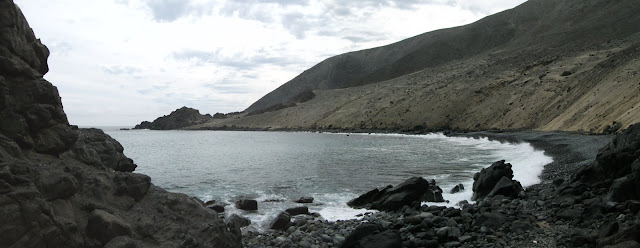
After some shouting and whistling, a couple appeared. The guy, Javier, had a long knife with him that he uses to cut the algae, and his wife, Lucia, had binoculars she uses to find out where the algae are floating to. To our surprise, we weren´t the first cyclists passing there. Just a week before, a brave German cyclist who met them decided to continue along the coast with his bike and a huge water bag, without any kind of road. Javier and Lucia have been professional algae hunters for the past few years.
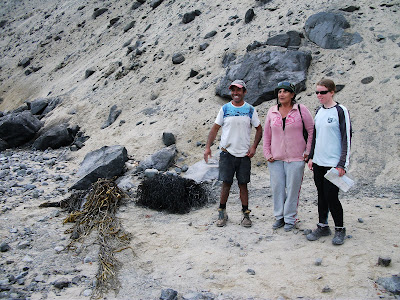
They make about 3 million CH$ (about 6,500 US$) per month, and spend almost nothing due to their humble living conditions. This income plus the huge smiles all the algae hunters have made us think they are all quite rich. Javier told us how they cheat the people who buy the algae from them by soaking the algae in water to make them heavier. They know a lot about sea food which is abundant in this beach where they have been living in the past 4 years. As they assured us that the algae was edible, we tried some and it wasn´t too bad. Lucia loves collecting stones from the area, and insisted on giving some to us. She said she was trying to clean the beach from the garbage people left behind, but as it seems, she still has a lot of work to do. Eventually we had to leave, and started the climb by foot due to a bad road. Soon we could cycle it again, but we went up slowly.
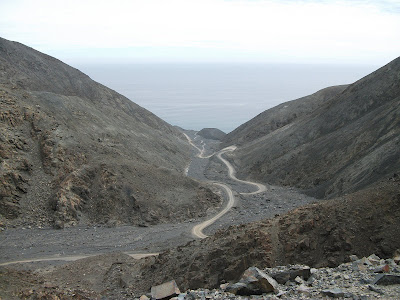
During the climb, we where debating the option of hitch-hiking. A decision about that matter wasn´t necessary though, as no vehicle passed us that day. After riding uphill for 13 km, we camped, exhausted.
He was happy to explain to us about the history of the place. The mine was active until 15 years ago, and soon it should be reactivated. There are piles of rocks there containing various minerals. These gurds are there to protect the place from theft of the expensive equipment that was left. About a month ago was the last armed robbery attempt during the night, were the robbers tried to take the expensive satellite phone (20,000 US$) the guards use. Nacho let us fill in water and we finished the water tank, so Amit went with him to fetch a new one. He made us an interesting traditional drink from toasted flour, a bit of sugar and a lot of water. Surprisingly it was very tasty and also quite filling.
The End of the Road
Shortly after leaving, we reached a junction. The road to the right snaked all the way up the mountain, and it was easy to choose to avoid it and continue along the coast.
After some 10 km, the illusion was gone. On way or another we would have to climb, as our road turned right towards the mountains. We weren´t even sure if the road would lead us to Antofagasta, so we hiked down to the coast where we spotted a shed.
After some shouting and whistling, a couple appeared. The guy, Javier, had a long knife with him that he uses to cut the algae, and his wife, Lucia, had binoculars she uses to find out where the algae are floating to. To our surprise, we weren´t the first cyclists passing there. Just a week before, a brave German cyclist who met them decided to continue along the coast with his bike and a huge water bag, without any kind of road. Javier and Lucia have been professional algae hunters for the past few years.
They make about 3 million CH$ (about 6,500 US$) per month, and spend almost nothing due to their humble living conditions. This income plus the huge smiles all the algae hunters have made us think they are all quite rich. Javier told us how they cheat the people who buy the algae from them by soaking the algae in water to make them heavier. They know a lot about sea food which is abundant in this beach where they have been living in the past 4 years. As they assured us that the algae was edible, we tried some and it wasn´t too bad. Lucia loves collecting stones from the area, and insisted on giving some to us. She said she was trying to clean the beach from the garbage people left behind, but as it seems, she still has a lot of work to do. Eventually we had to leave, and started the climb by foot due to a bad road. Soon we could cycle it again, but we went up slowly.
During the climb, we where debating the option of hitch-hiking. A decision about that matter wasn´t necessary though, as no vehicle passed us that day. After riding uphill for 13 km, we camped, exhausted.
Dead Stove
As usual, we wanted to cook the usual poredge for breakfast, but this time we had no luck. Our stove just stopped working. Amit tried to revive it, but with no success. Eventually we gave up and ate the oat meal raw with sugar and cinnamon. This turned out to be quite good and easier to make! We proceeded to climb again. It was 5 km to the junction with the road we saw the day before near El Cobre, and 3 km more to the top.
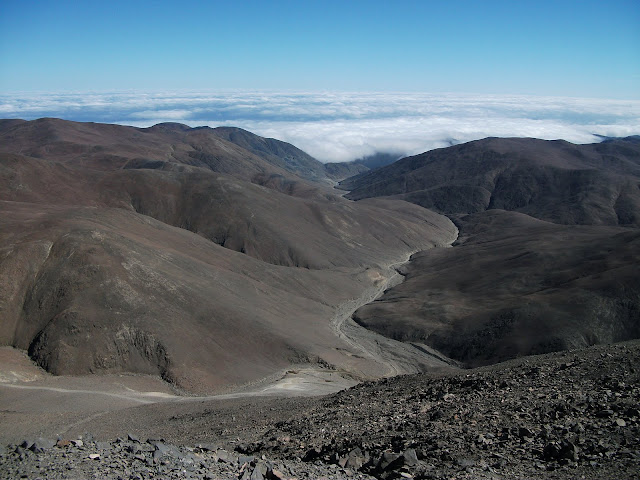
It was mainly downhill from there, and after 17 km we finally reached asphalt. This was the new road from Paposo. It was indeed neatly paved and almost empty from traffic. When we reached the junction with Ruta 5 after 15 easy km, our hopes for cooked lunch were lost, as there was no Posada near us and we were starving. We ate dry crackers and peanuts. From there it was face wind for 30 km. We were able to cheat a bit by riding close to each other thus shading the wind. We reached a row of various stinking factories, and where happy when we left the road towards Antofagasta.

The entrance to the city for trucks and buses is only allowed at certain hours of the day, but we were unlucky, and so had the company of many. The entrance to the city was quite impressive with skyscrapers and a lovely promenade along the beautiful beach.
It was mainly downhill from there, and after 17 km we finally reached asphalt. This was the new road from Paposo. It was indeed neatly paved and almost empty from traffic. When we reached the junction with Ruta 5 after 15 easy km, our hopes for cooked lunch were lost, as there was no Posada near us and we were starving. We ate dry crackers and peanuts. From there it was face wind for 30 km. We were able to cheat a bit by riding close to each other thus shading the wind. We reached a row of various stinking factories, and where happy when we left the road towards Antofagasta.
The entrance to the city for trucks and buses is only allowed at certain hours of the day, but we were unlucky, and so had the company of many. The entrance to the city was quite impressive with skyscrapers and a lovely promenade along the beautiful beach.